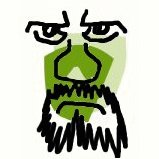It Would Not Have Happened in a Library
The sketch lacked details. Due to the cold I'd economized in drawing, but now I needed a train. Flex the fingers. Whistle blows. This should only take a moment.
An image search for trains quickly take me to examples of graffiti. A site advises to not paint trains because of the danger of sparks in tunnels, silently moving trains and cars being bumped. It lists three experienced graffiti artists killed while painting trains. But if you do paint them, it adds, be sure to use the foot bridges.
It's an enormous site with all kinds of graffiti from all over the world, yet it leaves me wondering why so much is so similar. Rather than the application of paint to varying surfaces, it seems to be the formulaic exercise of a very limited range of styles. Maybe I need to look more.
Graffiti leads me to stumble across an artist called Conor Harrington. He strikes me as like David Salle, but better. I go looking for Salle to remind me, finding him at the Gagosian.
At Gagosian.com I spot Howard Hodgkin's name. Just a couple of his paintings there so I keep searching. Tiring of the limitations of image-searching, I return to the mainstream and find myself at the BBC listening to an short interview. My favorite respsonse is when Howard is clearly insulted by the possible suggestion that any marks of paint he may make might be on impulse. He being a professional artist is deemed explanation enough for why nothing he paints is ever impulsive.
Artnet satisfies my now raised curiosity for a quick fix of Hodgkin's paintings, but it leaves me remembering how I used to paint model airplanes. It's particularly the Messerschmitt Me 110 I'm remembering. Yes I know, we were supposed to buy the Allied models and paint those good guys but there was always lots of Me 110s available, and they had bigger wings for painting. I liked to paint the entire underneath in a bright red with rough black spots, because we all know that the sky when you look up is often bright red with black spots. Try it some time by looking into the sun. See? Chances are you missed a flock of Messerschmitts flying past.
So the first time I stood in a gallery looking at a Howard Hodgkin I was staring at my childhood and a very painterly World War II. Not the most effective camouflage but then camouflage is about disruption and confusion in plain view rather than necessarily blending in seamlessly to a background which might not stay constant anyway. If done effectively, the edges, the form, of what is being camouflaged, is blurred or indistinct. Razzle Dazzle.
So I go back a World War. Dazzle Patterns. Ship Camouflage. During World War I, German u-boats threatened supply lines to Allied forces in Europe. Dazzle camouflage broke up the visual shape of the ships, confusing those aiming torpedoes as to direction and speed of the vessel. Derived originally from Cubism, Picasso was an early influence. Oddly it was evident that the British and the French employed patterns that foretold Op Art whereas America was more inclined to designs that foretold Color Field painting. I, born so many years after my time, merely foretold Howard Hodgkin, albeit with hindsight.
Perhaps I don't need that detail to paint a train after all.
Paul Dorrell counsels you to "take in all you can of the past and present, and the future too if it speaks to you."










0 Comments:
Post a Comment
<< Home